|
|
|
Sort Order |
|
|
|
Items / Page
|
|
|
|
|
|
|
| Srl | Item |
| 1 |
ID:
087393
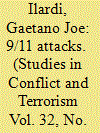

|
|
|
|
|
| Publication |
2009.
|
| Summary/Abstract |
The 9/11 attacks on New York and Washington, D.C. were undoubtedly the most brazen and shocking terrorist attacks conducted by a sub-state group in history. Al Qaeda's capacity to achieve this outcome depended in large part on its meticulous intelligence and counterintelligence preparations. These activities allowed Al Qaeda to exert a strong measure of control over its operating environment, leading to a confidence that events would unfold as planned. Moreover, intelligence and counterintelligence allowed Al Qaeda to form highly accurate and realistic assessments of its environment, an outcome that helps to dispel notions of an organization consumed by a level of fanaticism that distorts its perception of reality, or else frustrates its capacity to engage in rational decision making
|
|
|
|
|
|
|
|
|
|
|
|
|
|
|
|
| 2 |
ID:
087056
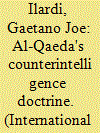

|
|
|
|
|
| Publication |
2009.
|
| Summary/Abstract |
It is up the leadership and individuals to make continuous effort to reach a perfect security image that could achieve the required target. It is up to each group to keep developing and innovating security measures that suit the development of the enemy's abilities to benefit from previous trials and renewed experiences and to be familiar with whatever is new with regards to the opposing security of the group's movement.
|
|
|
|
|
|
|
|
|
|
|
|
|
|
|
|
| 3 |
ID:
130235
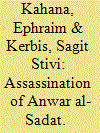

|
|
|
|
|
| Publication |
2014.
|
| Summary/Abstract |
Within the context of intelligence, the assassination of Egypt's President Muhammad Anwar al-Sadat on 6 October 1981 can be characterized as both a symbolic security failure and a failure to implement professional security principles by those responsible for guarding his life.
The circumstances creating the security "hole" were not confined to the short period preceding the assassination, but rather began long before, as part of an intense clash between two conflicting forces: extreme Islam and modern statehood.
In contrast to prevailing opinion, the apex of the struggle between these two forces is the main reason for the assassination, and not Sadat's peace with Israel. 1 The assassins of the al-Jihad group, springing unchecked from the substratum of fundamentalist Islam, carried out their work resolutely, exploiting the circumstances with almost incredible ease.
The sixth of October, observed in Egypt as a day of military triumph over the Israel Defense Forces (IDF) in the October 1973 War (the Yom Kippur War), is celebrated as an official holiday at the Grave of the Unknown Soldier on the outskirts of Cairo. On that date in 1981, on the reviewing stand stood President Sadat and his entourage: Vice President Hosni Mubarak; Defense Minister Mohammad Abu-Gazala; members of parliament; and members of the diplomatic corps, among them Israeli Ambassador Moshe Sassón.
Mirage fighter planes flew in celebratory formation above, and all in attendance were occupied with watching them and the huge parade passing before the reviewing stand, as columns of soldiers marched past the proud president.
When it was the artillery unit's turn to pass, a military truck stopped suddenly, from which four uniformed men sprang. Thinking this was part of the pageantry, no security personnel acted to prevent them from approaching the reviewing stand. One of the men quickly threw a grenade that did not explode, followed by more grenades. The assassins cocked their weapons and charged, firing at those on the reviewing stand.
The speed and suddenness with which the assassination was carried out resulted in pandemonium. People ran in all directions to take cover while Sadat stood, stiff and in shock, making him a clear target for sniper Hussein Abbas, 2 who shot him in the neck and chest. Sadat collapsed on the spot, yet this did not prevent another assassin, Abed al-Hamid, from emptying the rest of his rifle's magazine unhindered to confirm the kill. Sadat was flown by Gazelle helicopter to the Armed Forces Military Hospital at Ma'adi, but he arrived with no pulse, as his chest and arteries had been fatally penetrated.
The individual responsible for the assassination was Captain Khalid al-Islambouli. The fact that he and his partners managed to carry out this "inside job," despite explicit warnings having been received of threats on the president's life at the parade, testifies to a complete absence of common sense on the part of the Egyptian security sector.
The head of the Israeli security unit and lead investigator of the assassination, who was also responsible for Ambassador Sasson's rescue, was Avraham Rotem. According to Rotem, some members of Sadat's security detail were known to Rotem's unit personally due to previous reciprocal visits between Israeli and Egyptian personnel. 3 For this reason, the part played by Egyptian security personnel that day remains a mystery, due precisely to Israel's familiarity with them and the fact that they had acquired their security expertise from the best American instructional training. Sadat's assassination therefore raises a number of burning questions emanating from the fact that many in the upper Egyptian echelons knew that Sadat was in the opposition's crosshairs.
|
|
|
|
|
|
|
|
|
|
|
|
|
|
|
|
| 4 |
ID:
191087
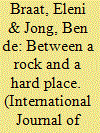

|
|
|
|
|
| Summary/Abstract |
While scholarly literature has paid attention to human intelligence professionalism from the perspective of the agent handler, we know relatively little about the precarious positions in which (double) agents often find themselves and what their ensuing needs from their handlers consist of. This article suggests that (double) agents desire a reciprocal, affect-based relationship with their handlers, involving trust and gratitude, more than just a negotiated relationship based on (financial) agreements. This article explains the importance of such a relationship. The main source of this research consists of original, in-depth oral history interviews with former double agent “M.” He operated from the 1960s through the 1990s for the Dutch Security Service and the Central Intelligence Agency against the East German Ministerium für Staatssicherheit. The article analyzes the varying degrees of appreciation that these services showed for his work, and it investigates their consequences on the psychological well-being of the double agent.
|
|
|
|
|
|
|
|
|
|
|
|
|
|
|
|
| 5 |
ID:
167491
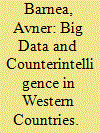

|
|
|
| 6 |
ID:
164563
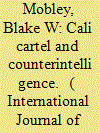

|
|
|
| 7 |
ID:
091230
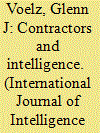

|
|
|
|
|
| Publication |
2009.
|
| Summary/Abstract |
At this juncture ongoing military operations and growing demand for domestic counterterrorism information will likely necessitate continuing reliance on private sector augmentation into the foreseeable future. Given this assumption, the time has arrived for the government to move beyond viewing its commercial augmentation as an ad hoc resource without having clear strategies and policy for its use.
|
|
|
|
|
|
|
|
|
|
|
|
|
|
|
|
| 8 |
ID:
123226


|
|
|
|
|
| Publication |
2013.
|
| Summary/Abstract |
The Kingdom of Hungary had to face a post-war clutter in 1918-1919. Each center of power tried to establish a kind of armed forces and police in this period. For a long time, Hungary did not have a general staff. Therefore, the Ministry of Defense had an office which worked like general staff, severely 'sub rosa'. Officially the Hungarian General Staff and the branch for intelligence and/or counterintelligence were established in 1938. It had good relationship with its German counterpart and included the Hungarian entity for political investigations. The officials knew which German officer had a Hungarian "connection" and who this person was. It is only a historical quaintness that soldiers or Reichssicherheitshauptamt (Reich Security Main Office [RSHA]) officers and Hungarian police officers joined Office of Strategic Services (OSS) after World War II.
|
|
|
|
|
|
|
|
|
|
|
|
|
|
|
|
| 9 |
ID:
167475
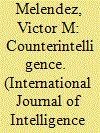

|
|
|
| 10 |
ID:
154060
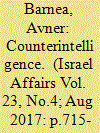

|
|
|
|
|
| Summary/Abstract |
This article discusses the differences between strategic intelligence and counterintelligence, a much less researched subfield of the intelligence discipline. One reason for this scholarly neglect is the perception of counterintelligence as highly sensitive due to its preoccupation with internal affairs, considered too confidential for open discussion. Another reason is the apparent lack of understanding of the real contribution of counterintelligence to national security. This article seeks to fill this scholarly lacuna.
|
|
|
|
|
|
|
|
|
|
|
|
|
|
|
|
| 11 |
ID:
138806


|
|
|
|
|
| Summary/Abstract |
Following the passage of the Counterintelligence (CI) Enhancement Act of 2002 1 U.S. government agencies that conduct CI have sought to increase collaboration with the public, other organizations and businesses, through partnerships and alliances. Despite these successes, CI personnel may underestimate what they have to offer to interested third parties who could become critical allies. Hence the question: How should CI outreach be conducted and shaped in order to create a strategic CI advantage? Correlative questions include: Should outreach operations and networks stay the same, evolve slowly, incrementally, or naturally over time, or be radically altered? How might current outreach programs be re-configured or deployed in order to meet evolving intelligence threats, operations, and challenges? While law enforcement has its informant networks, and traditional intelligence agencies often focus on managing their case load of assets, CI organizations may lack a strategically assembled network of support. Yet, organizations can evaluate their outreach operations and clients and then calibrate their network of relationships to enhance effectiveness and create a durable advantage over their adversaries.
|
|
|
|
|
|
|
|
|
|
|
|
|
|
|
|
| 12 |
ID:
144666
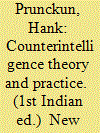

|
|
|
|
|
| Edition |
1st Indian ed.
|
| Publication |
New Delhi, Pentagon Press, 2014.
|
| Description |
xv, 239p.hbk
|
| Standard Number |
9788182747920
|
|
|
|
|
|
|
|
|
|
|
|
Copies: C:1/I:0,R:0,Q:0
Circulation
| Accession# | Call# | Current Location | Status | Policy | Location |
| 058638 | 327.12/PRU 058638 | Main | On Shelf | General | |
|
|
|
|
| 13 |
ID:
122918
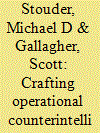

|
|
|
|
|
| Publication |
2013.
|
| Summary/Abstract |
Despite the potentially horrific implications of failure, counterintelligence (CI) is often viewed as the stepchild of the United States Intelligence Community (IC). The assertion has often been that CI in the U.S. has never worked due to the American culture and its frequent association with "mere" security. This was made even worse in many cases by the IC's shift from a counterespionage posture to a counterterrorism focus after the 11 September 2001 (9/11) attacks, 2 thereby creating unique challenges for CI managers. Unfortunately, relatively little focus has been placed on providing CI managers with useful ways to conceptualize and meet the unique day-to-day challenges they face.
|
|
|
|
|
|
|
|
|
|
|
|
|
|
|
|
| 14 |
ID:
140481


|
|
|
|
|
| Publication |
New Delhi, Lucky International, 2012.
|
| Description |
xvi, 196p.hbk
|
| Standard Number |
9788191060720
|
|
|
|
|
|
|
|
|
|
|
|
Copies: C:1/I:0,R:0,Q:0
Circulation
| Accession# | Call# | Current Location | Status | Policy | Location |
| 058279 | 322.420954/KUM 058279 | Main | On Shelf | General | |
|
|
|
|
| 15 |
ID:
134433


|
|
|
|
|
| Publication |
Stanford, Stanford University Press, 2014.
|
| Description |
241p.Pbk
|
| Contents |
Includes bibliographical references and index
|
| Standard Number |
9780804792653
|
|
|
|
|
|
|
|
|
|
|
|
Copies: C:1/I:0,R:0,Q:0
Circulation
| Accession# | Call# | Current Location | Status | Policy | Location |
| 057935 | 327.12/TUC 057935 | Main | On Shelf | General | |
|
|
|
|
| 16 |
ID:
130231
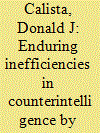

|
|
|
|
|
| Publication |
2014.
|
| Summary/Abstract |
A lot of time we are chasing shadows, but it's better to do that than find out later you let something get by. (An FBI field agent-Type I Error or a false positive). 1
The best chance for success [terrorists] have is to get somebody who is not a visitor [to] come in as a permanent resident or citizen, who knows the culture and how to move around, who doesn't have a record, so as not to get picked up by a database. (A former senior U.S. intelligence official-Type II Error or a false negative). 2
These two citations reflect divergent responses to the governance structures of terror organizations that continue to be subjects of interest and debate among scholars and practitioners. The operational character of terrorism remains essential to the development of strategic initiatives by counterintelligence (CI) agencies. To position CI more advantageously certain concepts from New Institutional Economics (NIE) might be utilized. 3 NIE's central formulation of principals and agents assumes that people make rational choices in determining whether to plan their transactions (relationship costs) into one of two kinds of configurations: market (decentralized) versus non-market (centralized) endeavors. Effectively, the challenge is to determine which transactional method offers greater prospects to achieve efficiency. Inherent limitations (externalities) of time, place and resources complicate these choices. Those involved can be divided into owners (principals) and workers or suppliers (agents). In fulfilling any agreed upon duties, transaction costs then center on the degree to which principals undertake monitoring the behavior of agents for possible shirking-referenced by NIE as the "agency problem."
|
|
|
|
|
|
|
|
|
|
|
|
|
|
|
|
| 17 |
ID:
164565
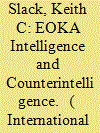

|
|
|
| 18 |
ID:
116384
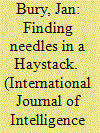

|
|
|
|
|
| Publication |
2012.
|
| Summary/Abstract |
The declassification of formerly Communist Poland's secret police files in recent years allows a broader look at the country's counterintelligence operations conducted during the Cold War. These documents permit extraordinary insight into the capabilities of the Polish counterintelligence apparatus and its perception of Western intelligence tradecraft. These sources, now stored at the Polish Institute of National Remembrance (IPN), disclose the methods and tools implemented by the Eastern Bloc's counterintelligence services which led to their many successes.
|
|
|
|
|
|
|
|
|
|
|
|
|
|
|
|
| 19 |
ID:
110002
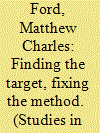

|
|
|
|
|
| Publication |
2012.
|
| Summary/Abstract |
This article is concerned with exploring the recent observations of Lieutenant-General Lamb who stated that there was no simple binary between counterintelligence (COIN) and counterterrorism (CT). Specifically, the article will use the intelligence-gathering, assessment, and target identification processes and methods used on operations in Iraq and Afghanistan to examine this further. What makes this an interesting exercise is that the effectiveness of a COIN/CT intervention totally depends on whether an insurgent has been properly identified. If the wrong person has been targeted then kinetic, influence, or policing activities are at best exploratory and at worst wasteful or even positively harmful. Thus, by investigating the intelligence model that frames the way adversaries and communities are identified, it becomes possible to understand the limitations in the processes and methods used. At the same time this approach makes it possible to cast light on how and to what extent various techniques drawn from COIN and CT work together in Overseas Contingency Operations.
|
|
|
|
|
|
|
|
|
|
|
|
|
|
|
|
| 20 |
ID:
130233
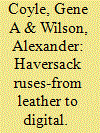

|
|
|
|
|
| Publication |
2014.
|
| Summary/Abstract |
The historical record of a country allowing false documents to fall into the hands of its enemy in order to deceive him goes back at least as far as the third century B.C., when Hannibal fought the Romans. 1 Yet, the ploy of misleading an enemy through the "passage" of fake documents to the other side probably reached its zenith during the twentieth century's First and Second World Wars, especially with a few spectacular cases involving an allegedly wounded courier and, once, even a dead one. Because of the famous British deception ploy in Palestine against the Turks in 1917, most all such deceptions came to be known as "haversack ruses." The king of all such ruses, at least in terms of being the best-known through numerous books and even a movie, was Operation MINCEMEAT of World War II. This elaborate British ploy of 1943 employed a dead body, a submarine to deliver it off the coast of Spain, false documents to deceive Germany's Adolf Hitler about the date and location of an anticipated Allied invasion of southern Europe, and the painstaking creation and backstopping of "The Man Who Never Was."
The purpose of examining variations of this type of ruse is to determine if these ploys featured any common characteristics, as well as any commonality in the backgrounds and personalities of the people who came up with or implemented such ideas. Did they include traits that make for a good deception officer? One of the World War II "deceivers," Sefton Delmer, wrote years later that, in wartime London, many of his most successful deception ideas came to him while drinking vintage champagne at Frascati's, his favorite expensive restaurant with its plush chairs and elderly waiters. 2
At first glance, the haversack ruses seem to have ended with the close of World War II, but perhaps the medium simply changed from leather satchels to digital ones. The challenge of looking at relatively recent "digital haversack" deceptions is that most instances remain classified, but a few Western ploys against the Soviet Union in the early 1980s have entered the public domain. The delivery methods of modern deceptions have changed, but the goal of misleading the enemy is still the same. Although no exciting tales involving dead bodies have surfaced-just the use of dull digital zeros and ones from computer files-the results may occasionally be equally exciting. And the need still exists for imaginative, operational minds in today's deception operations.
|
|
|
|
|
|
|
|
|
|
|
|
|
|
|
|
|
|
|
|
|